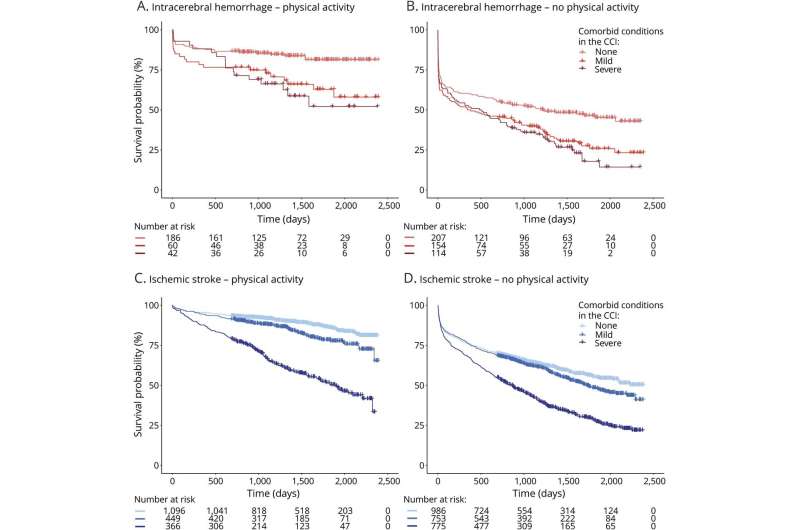Study links light physical activity to milder symptoms from intracerebral hemorrhage

Four hours of light physical activity per week can now be linked to milder symptoms from intracerebral hemorrhage, and also to better survival rates, a University of Gothenburg study shows.
Intracerebral hemorrhage is the most serious type of stroke with few treatment options. About one in ten cases of stroke is an intracerebral hemorrhage, a condition caused by bleeding within the brain tissue, with high risk of death and disability.
In the current register-based study, researchers from Sahlgrenska Academy at the University of Gothenburg show a clear link, although not causality, between physical activity and protection against severe symptoms of intracerebral hemorrhage.
The results show that people who perform light physical activity, such as walking or bicycling for at least four hours per week, have a 3.5 times higher probability to experience mild symptoms from intracerebral hemorrhage, and more than twice the chance to survive five years, compared to those who are less active.
Common stroke symptoms include, paralysis (usually in one half of the body), slurred speech, loss of vision, dizziness with balance difficulties, severe headache and loss of consciousness.
First author of the study, published in the journal Neurology, is Adam Viktorisson, a Ph.D. student in Clinical Neuroscience at Sahlgrenska Academy, and a medical intern at Sahlgrenska University Hospital in Gothenburg.
"This is the first study that examines the relationship between physical activity, acute stroke symptoms and death after intracerebral hemorrhage. The results show that light physical activity, such as taking a walk or cycling for at least 35 minutes per day, markedly reduces the likelihood of severe symptoms and death after intracerebral hemorrhage," he says.
The study includes all patients treated for intracerebral hemorrhage at Sahlgrenska University Hospital in between 2014 and 2019. A total of 763 people with intracerebral hemorrhage and a comparison group of 4,425 people with ischemic stroke (cerebral infarction) were included. The average age was 73 years and 50% were women.
In the study, over half were inactive before their intracerebral hemorrhage, 1 in 3 performed light physical activity, and less than 1 in 20 exercised regularly.
"Physical activity is not synonymous with exercise. Exercising means structured and repetitive physical activities done to strengthen muscles or improve fitness. Physical activity can be walking to work or going to the store. It is remarkable that even light physical activity seems to make a big difference. However, the study is based on an elderly population, for whom even light physical activities may be straining," Adam Viktorisson says.
The researchers have combined information from several Swedish registers: The local stroke register at the Sahlgrenska University Hospital (Väststroke), the national stroke register (Riksstroke), the Statistics Sweden Register, the Swedish National Patient Register and the Cause of Death Register. The follow-up of mortality continued until October 2021, up to 7 years.
The probability of surviving 5 years was 73% among those who were physically active before the intracerebral hemorrhage and only 33% among those who were inactive.
Of particular note is that those who were physically active but suffered from severe co-morbidity had higher survival rates, compared to those who were inactive but otherwise healthy.
"Hopefully this study can encourage people to be more physically active. That would reduce the number of severely injured patients and give them a better quality of life, and at the same time less burden on the healthcare system," says last author, Professor Katharina Stibrant Sunnerhagen.
More information: Adam Viktorisson et al, Associations of Prestroke Physical Activity With Stroke Severity and Mortality After Intracerebral Hemorrhage Compared to Ischemic Stroke, Neurology (2022). DOI: 10.1212/WNL.0000000000201097



















